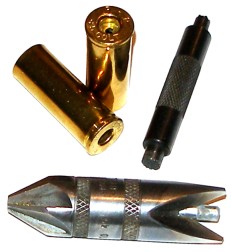 I’ve been too busy at work to replace a column on the front porch of the house. My grown children can’t understand why I fix things myself, always suggesting it would be easier to hire someone to do the work. A new column cost $117 and it would take two hours to knock out the job. The low bid from a contractor was $900. I’m either uniquely skilled at addition and subtraction, or the product of the circumstances of my childhood, but I don’t see a complex decision here.
I’ve been too busy at work to replace a column on the front porch of the house. My grown children can’t understand why I fix things myself, always suggesting it would be easier to hire someone to do the work. A new column cost $117 and it would take two hours to knock out the job. The low bid from a contractor was $900. I’m either uniquely skilled at addition and subtraction, or the product of the circumstances of my childhood, but I don’t see a complex decision here.
Over the past two weeks, I ran through 300 rounds of ammunition during the course of handload development for this project, basically making premium ammunition from piles of used brass. The component cost was $87. The online discount price for 300 rounds of factory good stuff $450. Deciding to handload does not require a complex thought process either.
Handloading either the .44 Remington Magnum or .45 Colt is a pretty straight forward process. They are big cases that headspace at the rim, probably work best with a good crimp, and both can be loaded to various levels of performance with either cast or jacketed bullets. The big decision with the .45 Colt is whether or not to push beyond SAAMI MAP levels of 14,000 PSI and crank them up to something more stout where the intended hardware is sufficiently strong to endure such an increase.
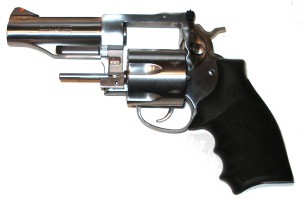 Personally, outside of recreational target shooting and perhaps CAS work, I can’t see the .45 Colt in standard pressure form as much of a cartridge. The circumstances that defined the original round were: weak brass, explosive black powder, firearms manufactured with century plus old machine tools, and less than exciting metallurgy. Consequently, original loads were anemic. Today, with none of these limitations any longer applicable and a number of strong firearms that can be used to extract more potential from the .45 Colt case. The Redhawk can use the same mainstream handloading manual data as the Blackhawk.
Personally, outside of recreational target shooting and perhaps CAS work, I can’t see the .45 Colt in standard pressure form as much of a cartridge. The circumstances that defined the original round were: weak brass, explosive black powder, firearms manufactured with century plus old machine tools, and less than exciting metallurgy. Consequently, original loads were anemic. Today, with none of these limitations any longer applicable and a number of strong firearms that can be used to extract more potential from the .45 Colt case. The Redhawk can use the same mainstream handloading manual data as the Blackhawk.
What is a stout handload and how will I know one if I see it?
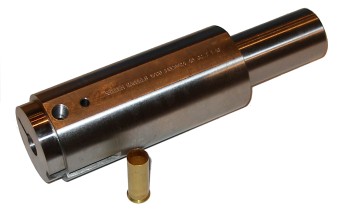 Anyone doing scratch or derivative handload development for modern .45 Colt handloads is faced with the same problem. A 35,000 PSI pressure ceiling may seem like a lot in comparison to the standard .45 Colt, but in the world of firearms, 35,000 PSI isn’t even enough to cause early warning signs of excessive pressure. Subsequently, ways must be found to reliably identify excess pressure conditions and to track pressure progression during load development. This is critical as bump pressure diminishes margins of safety.
Anyone doing scratch or derivative handload development for modern .45 Colt handloads is faced with the same problem. A 35,000 PSI pressure ceiling may seem like a lot in comparison to the standard .45 Colt, but in the world of firearms, 35,000 PSI isn’t even enough to cause early warning signs of excessive pressure. Subsequently, ways must be found to reliably identify excess pressure conditions and to track pressure progression during load development. This is critical as bump pressure diminishes margins of safety.
The safe solution to pressure checking is a somewhat elaborate universal receiver and test barrel, with supporting electronics, software and calibration and corroborating equipment. An alternative is a budget priced strain gauge setup, a worthwhile investment for any serious handloader. We tend to use both techniques depending on the circumstances and availability of test barrels for a specific cartridge. In the absence of an ability to analyze pressure results, the best bet is to stay with mainstream handloading manuals from component suppliers as the use of predictive software alone is not a valid approach.
QuickLOAD, is an exceptional predictive software product. Its author is reasonably conservative in his calculations, his product is well thought out and useful for a preliminary look. Unlike products like “Load from a Disk” or early public domain software that relies on categories of powder speed, QuickLOAD considers specific powder characteristics. It does not, however, take into consideration primer type, lot to lot powder variations, bullet construction, bore friction variation outside of bullet coatings, or even firearm type. The software also does not take into consideration the non-uniform pressure curve performance of powders intended for use in low pressure shotgun cartridges that are untested in a high pressure environment. It pains me to see folks with little or no handloading experience, post QuickLOAD output, complete with calculated pressures, as thought it were credible data. In a side my side comparison of QuickLOAD to conformal transducer generated results, the differences can be read in thousands of PSI.
 The 44 Remington Magnum loads appearing within this project reach CIP standards, or 40,000 psi range at the high end. .45 Colt loads run to the 35,000 psi range. Some handloads presented are not nearly as intense and are so noted.
The 44 Remington Magnum loads appearing within this project reach CIP standards, or 40,000 psi range at the high end. .45 Colt loads run to the 35,000 psi range. Some handloads presented are not nearly as intense and are so noted.
The maximum loads are intended to illustrate a ballistic potential. I would venture that none need to be loaded to these levels to be effective in use for hunting or wilderness protection. Backing off 5% is about maximum for some of the powders used without creating unpredictable pressure results.
The information appearing in this article is intended only for the Redhawk or Super Redhawk and not any other model from Ruger or any other manufacturer.
Bullet selection…
The most obvious thing you might notice about the bullets pictured below is that they are really, really big…or very small, depending on the size and resolution of your computer screen. In real life, without these Internet distortions of reality, they are all pretty much 0.429″ in diameter. Bullets selected for the .44 Magnum portion of the project are not intended to represent the best or most useful, they are only meant to be a cross section of weights and types. The lightest was included for reference only as it is too light for our .44 Magnum applications. As you’ll see, further along, the light bullet was able to achieve spectacular levels of velocity, but it also had the lowest level of penetration, retained the least weight and left the smallest wound channel.
|
|
||||
| Manufacturer Left to Right |
Type |
Weight Grains |
Diameter Inches |
Length Inches |
| Remington | Semi Jacketed Hollow Point | 180 | 0.4305 | 0.582 |
| Remington | Semi Jacketed Hollow Point | 240 | 0.4305 | 0.728 |
| Hornady | HP/XTP Jacketed Hollow Point | 240 | 0.4300 | 0.707 |
| Speer | Gold Dot Jacketed Soft Point | 270 | 0.4295 | 0.775 |
| Hornady | HP/XTP Jacketed Hollow Point | 300 | 0.4295 | 0.860 |
| Sierra | Sports Master Jacketed Soft Point | 300 | 0.4295 | 0.891 |
Bullets selected for the 0.451″ .45 Colt shift the range a little bit, beginning at 250 grains and moving upward into .454 Casull bullet weight territory at 360 grains. Half the bullets selected are cast, a habit from loading for my Ruger Single Action revolver where cast lead bullets have seen frequent use. It’s nice to have a gas check on a cast bullet, but not necessary at these levels of alloy hardness and muzzle velocity.
|
|
||||
| Manufacturer Left to Right |
Type |
Weight Grains |
Diameter Inches |
Length Inches |
| Hornady | HP/XTP Jacketed Hollow Point | 250 | 0.4520 | 0.665 |
| Nosler | Jacketed Hollow Point | 250 | 0.4510 | 0.676 |
| Oregon Trail | True Shot Cast SWC | 255 | 0.4530 | 0.692 |
| Hornady | XTP/Mag Jacketed Hollow Point | 300 | 0.4520 | 0.810 |
| Oregon Trail | True Shot Cast FP | 300 | 0.4525 | 0.797 |
| Oregon Trail | True Shot Cast WNFP | 360 | 0.4530 | 0.930 |
And then the rest of the gunk…
There are lots of choices for powders, however, I think the best for this application and bullet weight range are: AA No. 9, Alliant 2400, Lil’ Gun, H110, and W296. Primers – Yes, I favor their use and standardized on CCI 350. The influence on performance is minimal, the reliability of ignition is optimal and bullets were heavily crimped so I didn’t have to be concerned with magnum primers driving charges and bullets forward prior to significant ignition.
Winchester and Remington brass was used for .45 Colt loads, only Remington brass was used for .44 Remington Magnum loads. All brass had been previously fired. I arrived at this careful selection by digging around in the plastic brass jugs on my bench and grabbing whatever was available. I did not sort brass by: weight, color, date of birth, or ethnicity. I did decap them, crocogator them (a new verb), tumbled them, sized them and deburred them, then sent them on their way. In a world of full length resized brass and a couple of tenths variation in scale readings, the rest of the finesse prep some people do just didn’t apply.
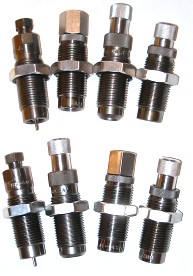 I used Lee Precision dies for all handloads. I do have dies from RCBS and Hornady for these cartridges, however, the Lee sets include the factory crimp die which is important. The crimp is applied as uniform lateral force rather than downward longitudinal and the case is sized by the same die after crimping to assure chambering won’t be a problem.
I used Lee Precision dies for all handloads. I do have dies from RCBS and Hornady for these cartridges, however, the Lee sets include the factory crimp die which is important. The crimp is applied as uniform lateral force rather than downward longitudinal and the case is sized by the same die after crimping to assure chambering won’t be a problem.
I came to Lee Precision Products late in the game and I am not a person who is easily convinced or changes my mind. I reluctantly tried Lee factory crimp dies when I was on a project to quantify the strength of a crimp. The results were really good so I had to sputter for a bit, figure out how to reverse my earlier posture without being professionally embarrassed, and decided I could not. Now I use Lee Precision dies all of the time and give them the credit they deserve. Yes, I personally bought the dies used in this article. It is part of my penance for being a butthead early on when writing and it reminds me that a little humility is a good trait to have when you write about someone’s products.
Establishing maximum COL limitations
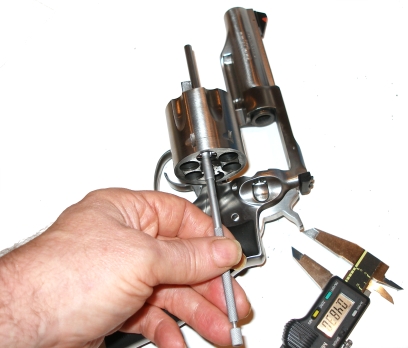 While cylinders in some guns may be longer, there is still an internal taper forward within a gun’s chamber that will eventually obstruct a long round. Finding that point in the cylinder, before a loaded round ahead of a falling hammer does, is typically…gratifying.
While cylinders in some guns may be longer, there is still an internal taper forward within a gun’s chamber that will eventually obstruct a long round. Finding that point in the cylinder, before a loaded round ahead of a falling hammer does, is typically…gratifying.
I’m sure any of the general purpose COL gauges would work but, if you don’t have one, an inexpensive telescoping gauge will work as well. All you really need to do is measure the largest diameter of a selected bullet that will protrude beyond the case mouth, then find where that dimension is located within the gun’s chamber.
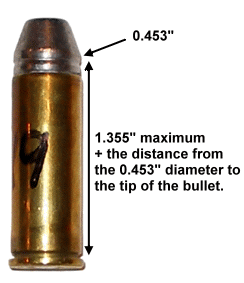 In the case of the 300 grain cast .45 Colt loads that follow, a 0.453″ diameter is present far forward on the bullet. I opened my calipers to 0.453″, expanded the telescoping gauge inside the jaws and locked it, then popped the gauge into a chamber to see at what point the chamber stopped the gauge from moving forward. The chamber tapers to 0.452″ at a depth of 1.355″. To that measurement I added the length of the bullet tip that extends beyond the 0.453″ diameter, rim thickness of 0.055″ and padded a few thousanths,. Maximum COL was set at 1.620″ for handloads using this bullet.
In the case of the 300 grain cast .45 Colt loads that follow, a 0.453″ diameter is present far forward on the bullet. I opened my calipers to 0.453″, expanded the telescoping gauge inside the jaws and locked it, then popped the gauge into a chamber to see at what point the chamber stopped the gauge from moving forward. The chamber tapers to 0.452″ at a depth of 1.355″. To that measurement I added the length of the bullet tip that extends beyond the 0.453″ diameter, rim thickness of 0.055″ and padded a few thousanths,. Maximum COL was set at 1.620″ for handloads using this bullet.
The big 360 grain cast slug handloads required no such accommodation. The long conical tip had lots of clearance so the overall length of the cylinder became the gating consideration. Jacketed bullets had no similar problems with either the .44 Magnum or .45 Colt. Both guns offer handloaders a good deal of latitude.
44 Remington Magnum Handloads
| .44 Remington Magnum Handloads | ||||||||
| Bullet Type |
Bullet Weight Grains |
Net Water Capacity Grains |
COL Inches |
Powder Type |
Powder Charge Grains |
Predicted Muzzle Velocity | Actual Muzzle Velocity |
Calculated K.E. ft-lbs |
| Remington SJHP | 180 | 30.2 | 1.607 | AA No.7** | 16.0 | 1265 | 1173 | 550 |
| AA No.9 | 25.0 | 1602 | 1644 | 1081 | ||||
| H110 | 31.5 | 1521 | 1609 | 1135 | ||||
| Lil’ Gun | 31.5 | 1714 | 1532 | 938 | ||||
| Remington SJHP | 240 | 24.5 | 1.603 | AA No.9 | 21.0 | 1425 | 1419 | 1073 |
| H110 | 24.8 | 1354 | 1390 | 1030 | ||||
| Lil’ Gun | 24.5 | 1403 | 1306 | 909 | ||||
| Hornady XP/XTP | 240 | 25.6 | 1.613 | AA No.9 | 21.3 | 1413 | 1400 | 1045 |
| H110 | 25.0 | 1328 | 1390 | 1030 | ||||
| Lil’ Gun | 24.5 | 1360 | 1372 | 1003 | ||||
| Speer Gold Dot JSP | 270 | 22.9 | 1.605 | H110 | 22.5 | 1235 | 1276 | 976 |
| Lil’ Gun | 22.5 | 1300 | 1247 | 933 | ||||
| W296 | 22.5 | 1250 | 1233 | 912 | ||||
| Hornady HP/XTP | 300 | 19.7 | 1.605 | H110 | 20.5 | 1201 | 1216 | 985 |
| Lil’ Gun | 20.0 | 1226 | 1259 | 1056 | ||||
| W296 | 20.5 | 1217 | 1244 | 1031 | ||||
| Sierra Sports Master JSP* | 300 | 23.4 | 1.736 | H110 | 22.0 | 1181 | 1225 | 1000 |
| Lil’ Gun | 22.2 | 1243 | 1220 | 992 | ||||
| W296 | 22.2 | 1211 | 1215 | 984 | ||||
| * Exceeds SAAMI maximum COL of 1.610″ and will not clear in a Blackhawk cylinder. This was an experiment intended to capitalize on the Redhawk’s long cylinder. ** Light recreational loads. | ||||||||
.45 Colt Handloads
Loading the .45 Colt, from a component standpoint, is not so different from the .44 Remington Magnum. Pressure levels are about 12% to 13% less, not out of respect for .45 Colt traditions, but rather in acknowledgement of the Redhawk Colt version’s 0.011″ thinner cylinder wall thickness and an approximate 25% increase in what rifle guys like to call bolt thrust. Not as a note of conservatism, but rather a real warning, if you shoot most of these loads in a Colt SAA or replica, or one of the newer small frame Ruger Vaqueros, they will come apart. In fact, if you don’t know that, stop reading this page and spend a little more time researching handloading and pressure basics.
| .44 Remington Magnum Handloads | ||||||||
| Bullet Type |
Bullet Weight Grains |
Net Water Capacity Grains |
COL Inches |
Powder Type |
Powder Charge Grains |
Predicted Muzzle Velocity | Actual Muzzle Velocity |
Calculated K.E. ft-lbs |
| Remington SJHP | 180 | 30.2 | 1.607 | AA No.7** | 16.0 | 1265 | 1173 | 550 |
| AA No.9 | 25.0 | 1602 | 1644 | 1081 | ||||
| H110 | 31.5 | 1521 | 1609 | 1135 | ||||
| Lil’ Gun | 31.5 | 1714 | 1532 | 938 | ||||
| Remington SJHP | 240 | 24.5 | 1.603 | AA No.9 | 21.0 | 1425 | 1419 | 1073 |
| H110 | 24.8 | 1354 | 1390 | 1030 | ||||
| Lil’ Gun | 24.5 | 1403 | 1306 | 909 | ||||
| Hornady XP/XTP | 240 | 25.6 | 1.613 | AA No.9 | 21.3 | 1413 | 1400 | 1045 |
| H110 | 25.0 | 1328 | 1390 | 1030 | ||||
| Lil’ Gun | 24.5 | 1360 | 1372 | 1003 | ||||
| Speer Gold Dot JSP | 270 | 22.9 | 1.605 | H110 | 22.5 | 1235 | 1276 | 976 |
| Lil’ Gun | 22.5 | 1300 | 1247 | 933 | ||||
| W296 | 22.5 | 1250 | 1233 | 912 | ||||
| Hornady HP/XTP | 300 | 19.7 | 1.605 | H110 | 20.5 | 1201 | 1216 | 985 |
| Lil’ Gun | 20.0 | 1226 | 1259 | 1056 | ||||
| W296 | 20.5 | 1217 | 1244 | 1031 | ||||
| Sierra Sports Master JSP* | 300 | 23.4 | 1.736 | H110 | 22.0 | 1181 | 1225 | 1000 |
| Lil’ Gun | 22.2 | 1243 | 1220 | 992 | ||||
| W296 | 22.2 | 1211 | 1215 | 984 | ||||
| * Exceeds SAAMI maximum COL of 1.610″ and will not clear in a Blackhawk cylinder. This was an experiment intended to capitalize on the Redhawk’s long cylinder. ** Light recreational loads. | ||||||||
Penetration Test Loads
 For each of the loads above, with the exception of those designated as light recreational, I assembled ammunition using the Lil’ Gun data that appears in the tables above, less a half grain of powder for Folgers penetration testing. I thought these were reasonable and closer to heavy, general purpose loads.
For each of the loads above, with the exception of those designated as light recreational, I assembled ammunition using the Lil’ Gun data that appears in the tables above, less a half grain of powder for Folgers penetration testing. I thought these were reasonable and closer to heavy, general purpose loads.
Performance from both cartridges were similar with jacketed bullets. I think the 180 grain Remington bullet is too light for the .44 Magnum. It had the shallowest penetration at only 17″, did not expand, but lost a full third of it’s weight in the process. Most everything else for both the .44 Remington Magnum and .45 Colt jacketed bullet loads penetrated in the 22″ – 23″ range, conformed to rifling, but did not expand. Heavy jacketed handgun bullets, even those labeled as “soft points” are in fact very hard. The jackets are very tough and the lead alloy core has a high antimony content. High meaning as high as 6%. They are made for deep penetration on big game and seem to perform as designed. Shooting was done with the muzzle of each gun approximately six feet from the test medium. The real heavy hitters were the cast bullets. The moderate weight 255 grain Colt load went 28″ into moist sawdust and silt, the 360 grain blew through all containers for 36″+ worth of penetration. By comparison, 9mm Luger, 40 S&W and .45 ACP hot loads are good for only 5″-12″ of penetration in the same material.
General shooting impressions
Both Ruger revolvers generated higher velocities than those produced by test fixtures. I would attribute this to tight 0.004″ – 0.005 cylinder gap, tight cylinder bores and forcing cones that may have increased operating pressure a bit. Performance as indicated from four inch revolvers is impressive. Both guns held up well to lots of heavy loads and showed virtually no wear and tear after a post shooting session dimensional check. Clean up was a wipe down with a lead removal cloth.
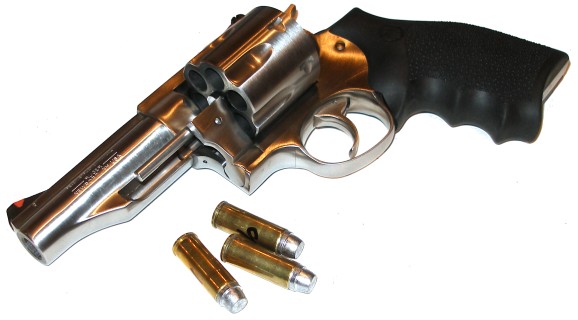
The grips are comfortable and shock absorbing, however, that didn’t stop me from whining and putting on a shooting glove after a few cylinders full of stiff handloads. Other than this little adjustment, shooting was routine. The sights are easy to pick up and hold on target. Trigger pull in both single and double action remained constant, never getting gritty or shifting pull weight. The loads I liked the least were those charged with W296. They were very sensitive to case crimp and they pushed a lot of muzzle flash. Lil’ Gun left the most favorable impression with greater charge efficiency, cleaner burn and significantly less apparent recoil.
Yes, .45 Colt version is the more appealing of the two chambers. I liked the heavier top bullet weights. Recoil, regardless load, didn’t seem as sharp, including the full up 360 grain loads. For wilderness carry in area not inhabited with brown bear, I think the .45 Colt with hot 255 grain loads would offer plenty of protection while remaining reasonable to shoot. In areas where larger game might be encountered, I’d probably load up with 360 grain loads. The Redhawk is an excellent shooter and an excellent value. Both the .44 Remington Magnum and .45 Colt versions offer a lot of potential to handloaders.
Additional related information:
Ruger Redhawks – A Case of Sibling Rivalry 44 Magnum and 45 Colt – Wilderness Protection
Handloading the .44 Remington Magnum and .45 Colt Ruger Redhawks – You can’t buy just one.

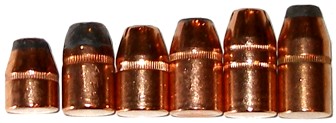
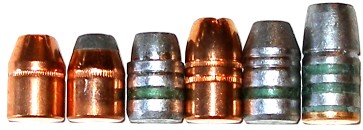
Email Notification